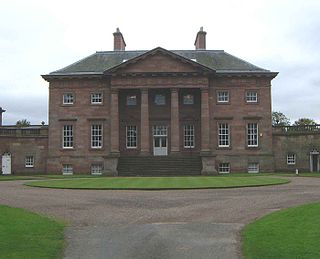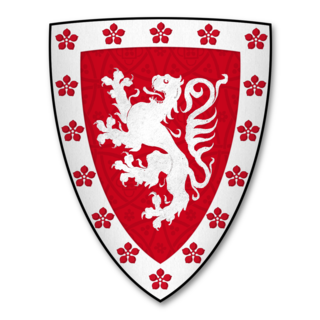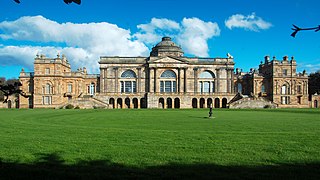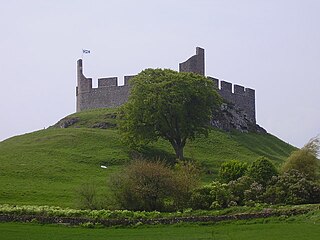
Robert Adam was a British neoclassical architect, interior designer and furniture designer. He was the son of William Adam (1689–1748), Scotland's foremost architect of the time, and trained under him. With his older brother John, Robert took on the family business, which included lucrative work for the Board of Ordnance, after William's death.

Paxton House is a historic house at Paxton, Berwickshire, in the Scottish Borders, a few miles south-west of Berwick-upon-Tweed, overlooking the River Tweed.

Blair Castle stands in its grounds near the village of Blair Atholl in Perthshire in Scotland. It is the ancestral home of the Clan Murray, and was historically the seat of their chief, the Duke of Atholl, though the current (12th) Duke, Bruce Murray, lives in South Africa. The castle stands in Glen Garry, and commands a strategic position on the main route through the central Scottish Highlands.

Patrick de Dunbar, 9th Earl of March, was a prominent Scottish magnate during the reigns of Robert the Bruce and David II.
Sir Robert Lauder of the Bass was a Scottish knight, armiger, and Governor of the Castle at Berwick-upon-Tweed. He was also a member of the old Scottish Parliament. The Lauders held the feudal barony of The Bass, East Lothian, Edrington Castle and lands in the parish of Mordington, Berwickshire, Tyninghame in Haddingtonshire, and numerous other estates and properties elsewhere in Scotland.

Gosford House is a neoclassical country house around 2 miles (3 km) northeast of Longniddry in East Lothian, Scotland, on the A198 Aberlady Road, in 5,000 acres (2,000 ha) of parkland and coast.

Clan Nesbitt is a Scottish clan of the Scottish Borders that is recognised by the Lord Lyon King of Arms.

Mellerstain House is a stately home around 8 miles north of Kelso in the Borders, Scotland. It is currently the home of George Baillie-Hamilton, 14th Earl of Haddington, and is designated as a historical monument.

Dirleton Castle is a medieval fortress in the village of Dirleton, East Lothian, Scotland. It lies around 2 miles (3.2 km) west of North Berwick, and around 19 miles (31 km) east of Edinburgh. The oldest parts of the castle date to the 13th century, and it was abandoned by the end of the 17th century.

Crichton Castle is a ruined castle near the village of Crichton in Midlothian, Scotland. It is situated at the head of the River Tyne, 2 miles (3.2 km) south of the village of Pathhead, and the same distance east of Gorebridge.

Clan Home is a Scottish clan. It held immense power for much of the Middle Ages and dominated the eastern Scottish Borders. It produced no fewer than eight Wardens of the Eastern March – more than any other family.

Dalmahoy is a hotel and former country house near Edinburgh, Scotland. It is located off the A71 road, 3.5 kilometres (2.2 mi) south of Ratho. The house is protected as a category A listed building,
Lamberton is a hilly, former landed estate in Berwickshire, Scotland, its eastern boundary being the North Sea. It is 4 miles (6.4 km) north of Berwick-upon-Tweed, on the Great North Road.

Hume Castle is the heavily modified remnants of a late 12th- or early 13th-century castle of enceinte held by the powerful Hume or Home family, Wardens of the Eastern March who became successively the Lords Home and the Earls of Home. The village of Hume is located between Greenlaw and Kelso, two miles north of the village of Stichill, in Berwickshire, Scotland.. It is a Scheduled Ancient Monument, recorded as such by Historic Environment Scotland.

Coldingham Priory was a house of Benedictine monks. It lies on the south-east coast of Scotland, in the village of Coldingham, Berwickshire. Coldingham Priory was founded in the reign of David I of Scotland, although his older brother and predecessor King Edgar of Scotland had granted the land of Coldingham to the Church of Durham in 1098, and a church was constructed by him and presented in 1100. The first prior of Coldingham is on record by the year 1147, although it is likely that the foundation was much earlier. The earlier monastery at Coldingham was founded by St Æbbe sometime c. AD 640. Although the monastery was largely destroyed by Oliver Cromwell in 1650, some remains of the priory exist, the choir of which forms the present parish church of Coldingham and is serviced by the Church of Scotland.

Dundas Castle is a 15th-century castle, with substantial 19th-century additions by William Burn, in the Dalmeny parish of West Lothian, Scotland. The home of the Dundas family since the Middle Ages, it was sold in the late 19th century and is currently the residence of politician and businessman Sir Jack Stewart-Clark. The tower house and the adjoining Tudor-Gothic mansion are listed separately as Category A buildings, and the grounds are included in Inventory of Gardens and Designed Landscapes in Scotland.

Marchmont House lies on the east side of the village of Greenlaw, and near to a church in Polwarth in Berwickshire, in the Scottish Borders area of Scotland. It is about five miles south west of Duns, about 19 miles (31 km) west of Berwick-upon-Tweed and about 40 miles (64 km) south east of Edinburgh. Situated in a gently undulating landscape, the estate is intersected by Blackadder Water, and its tributary burns. With the Lammermuir Hills to the north and views towards the Cheviot Hills in the south, this part of Berwickshire, sometimes referred to as the Merse, is scenic and contains rich agricultural land.

Lennox Tower is a ruinous fifteenth-century tower house at Lymphoy, near the Water of Leith, between Balerno and Currie, 11 kilometres (6.8 mi) south-west of Edinburgh, Scotland.

Bonkyll Castle was a medieval fortress situated in the historic Scottish county of Berwickshire, from 1973 the Scottish Borders. It is situated 4 miles north of Duns and 4 miles south of Grantshouse. Few traces survive and the site is protected as a scheduled monument. It was the seat of a junior branch of the Stewart family, known as "Stewart of Bonkyl", from which was descended in another junior branch "Stewart of Darnley", the paternal family of King James I & VI of Scotland and England.
Sir George Home of Wedderburn was briefly Comptroller of the Scottish Exchequer in the household to James VI of Scotland.




















